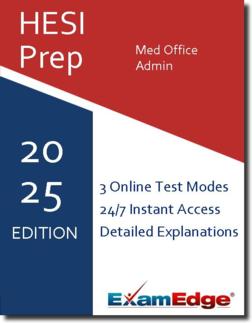HESI Med Office Admin (HESI-MA) Practice Tests & Test Prep by Exam Edge - Topics
Based on 40 Reviews
- Real Exam Simulation: Timed questions and matching content build comfort for your HESI Med Office Admin test day.
- Instant, 24/7 Access: Web-based HESI Medical Office Administration (CMAS,CMAA) Exit practice exams with no software needed.
- Clear Explanations: Step-by-step answers and explanations for your HESI exam to strengthen understanding.
- Boosted Confidence: Reduces anxiety and improves test-taking skills to ace your HESI Medical Office Administration (CMAS,CMAA) Exit (HESI-MA).

Understanding the exact breakdown of the HESI Medical Office Administration (CMAS,CMAA) Exit test will help you know what to expect and how to most effectively prepare. The HESI Medical Office Administration (CMAS,CMAA) Exit has multiple-choice questions The exam will be broken down into the sections below:
| HESI Medical Office Administration (CMAS,CMAA) Exit Exam Blueprint | ||
|---|---|---|
| Domain Name | % | Number of Questions |
| Office Procedures | 50% | 25 |
| Office Procedures Related to People | 10% | 5 |
| Office Procedures Related to Financial Documents, Correspondences, Files Forms, and Other Records |
26% | 13 |
| Office Procedures Related to Scheduling | 10% | 5 |
| Office Procedures Related to Healthcare Team Members and Community Resources | 2% | 1 |
| Office Procedures Related to Healthcare Information Research and Presentation | 2% | 1 |
| Financial Procedures | 30% | 15 |
| Financial Procedures Related to the Policies of the Organization | 10% | 5 |
| Financial Procedures Related to the Cash Flow of the Organization | 20% | 10 |
| Risk Management | 20% | 10 |
| Risk Management Related to People | 5% | 3 |
| Risk Management Related to Compliance | 15% | 8 |


